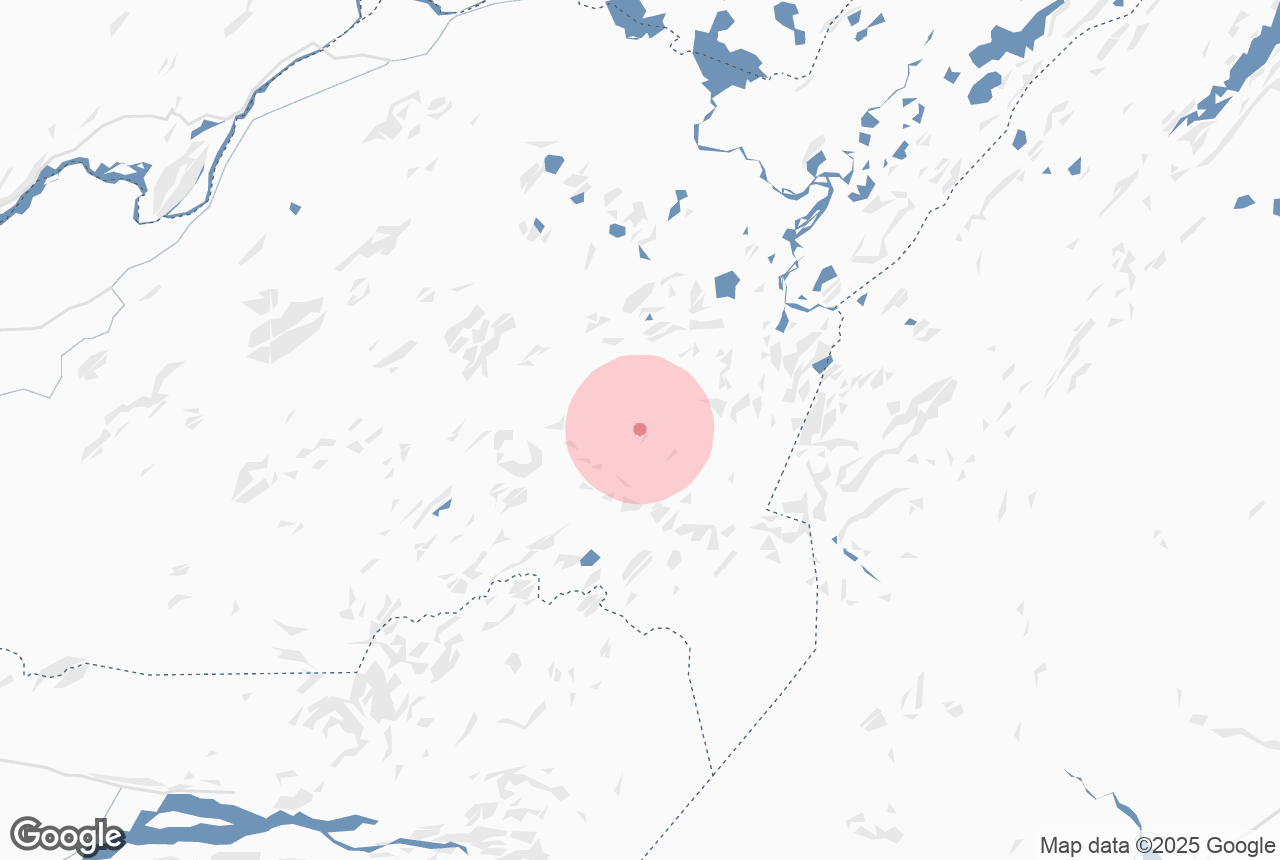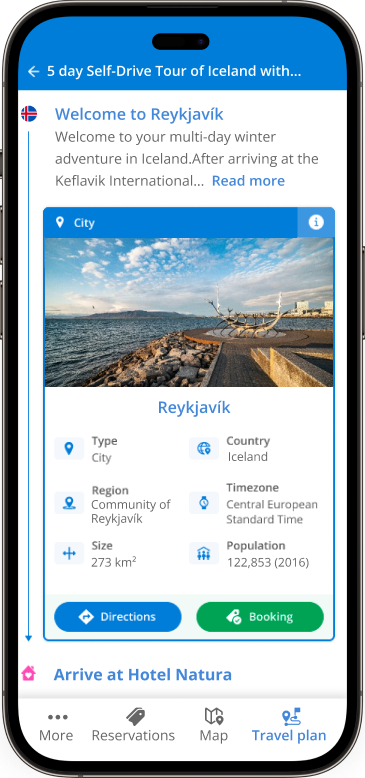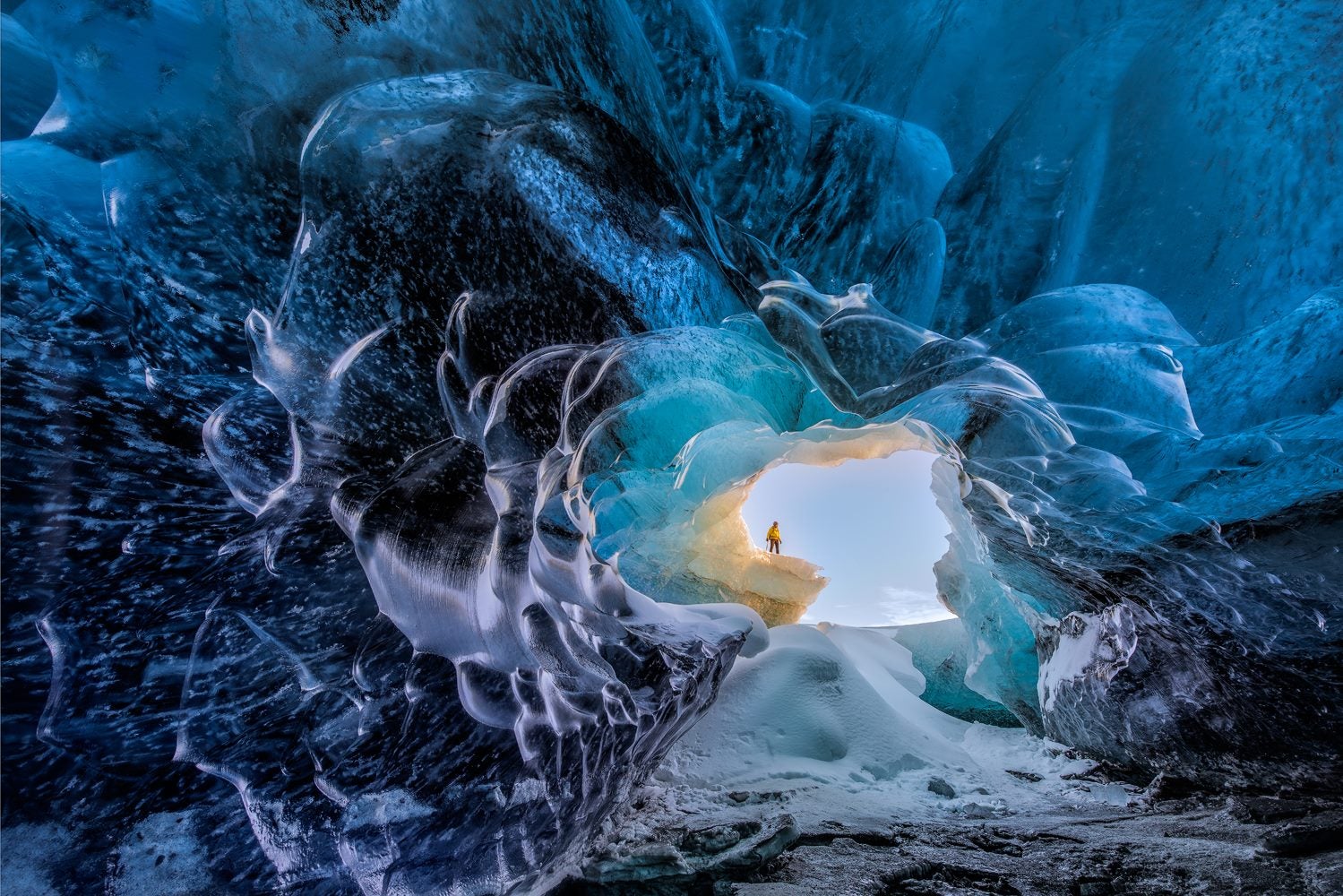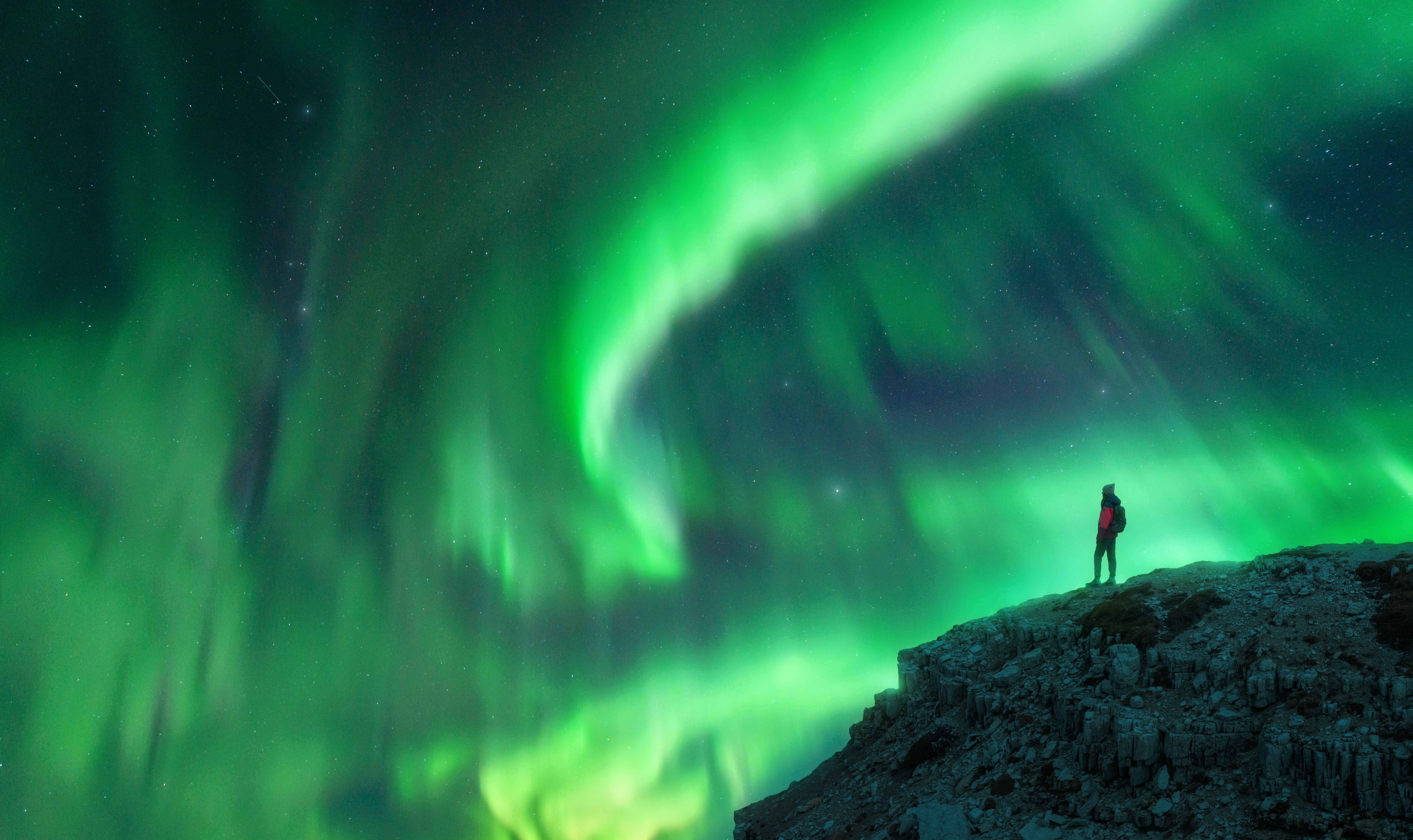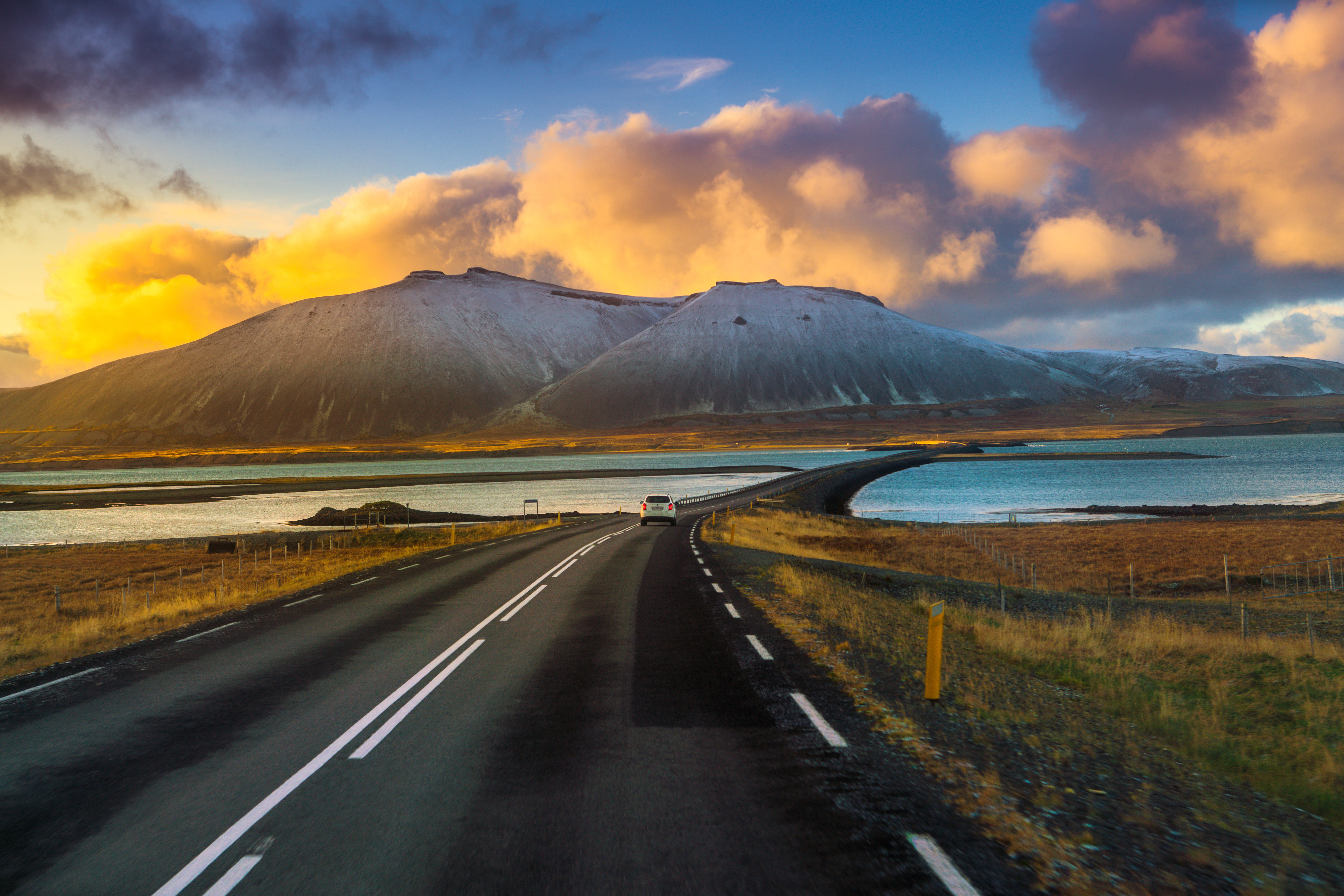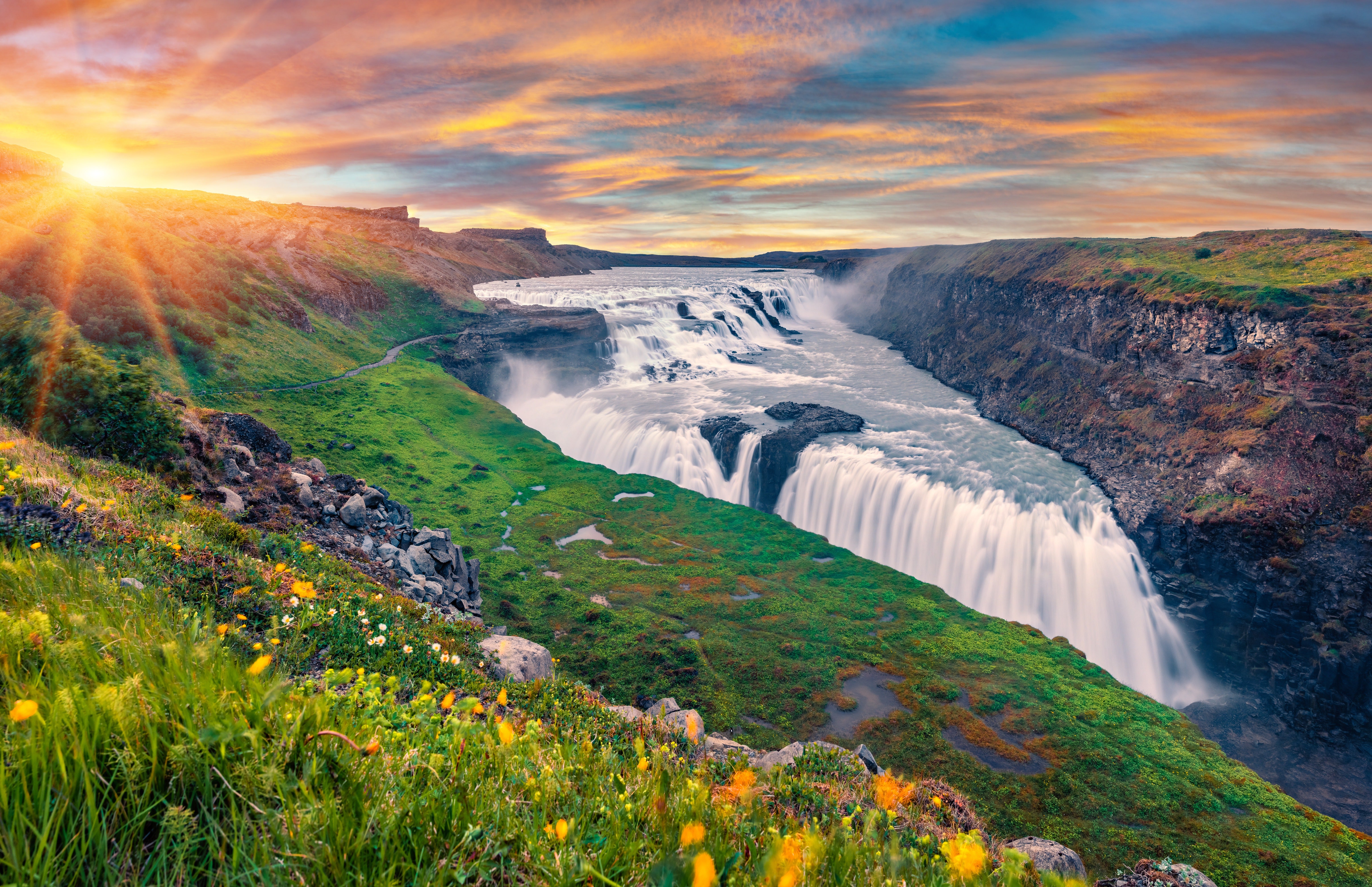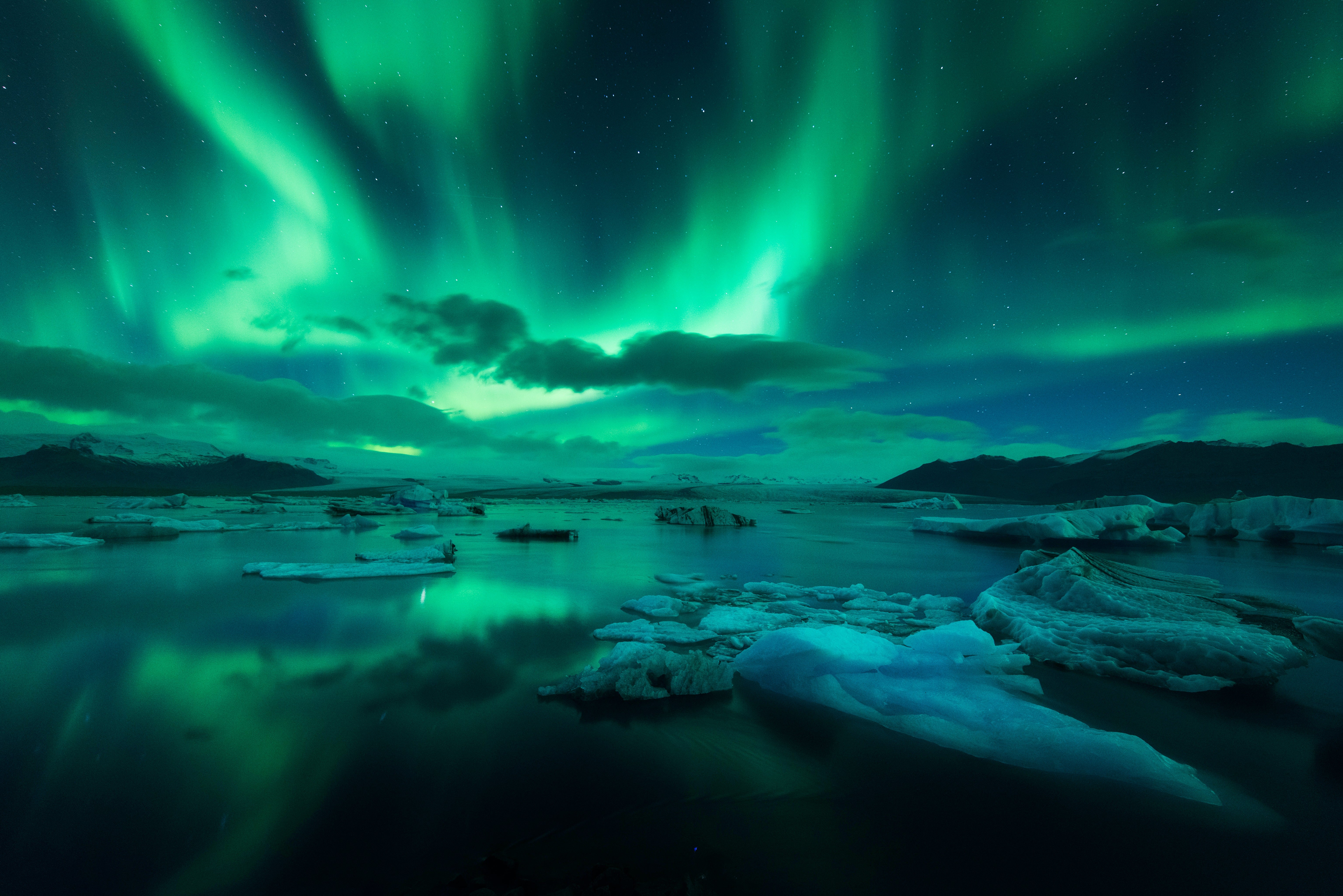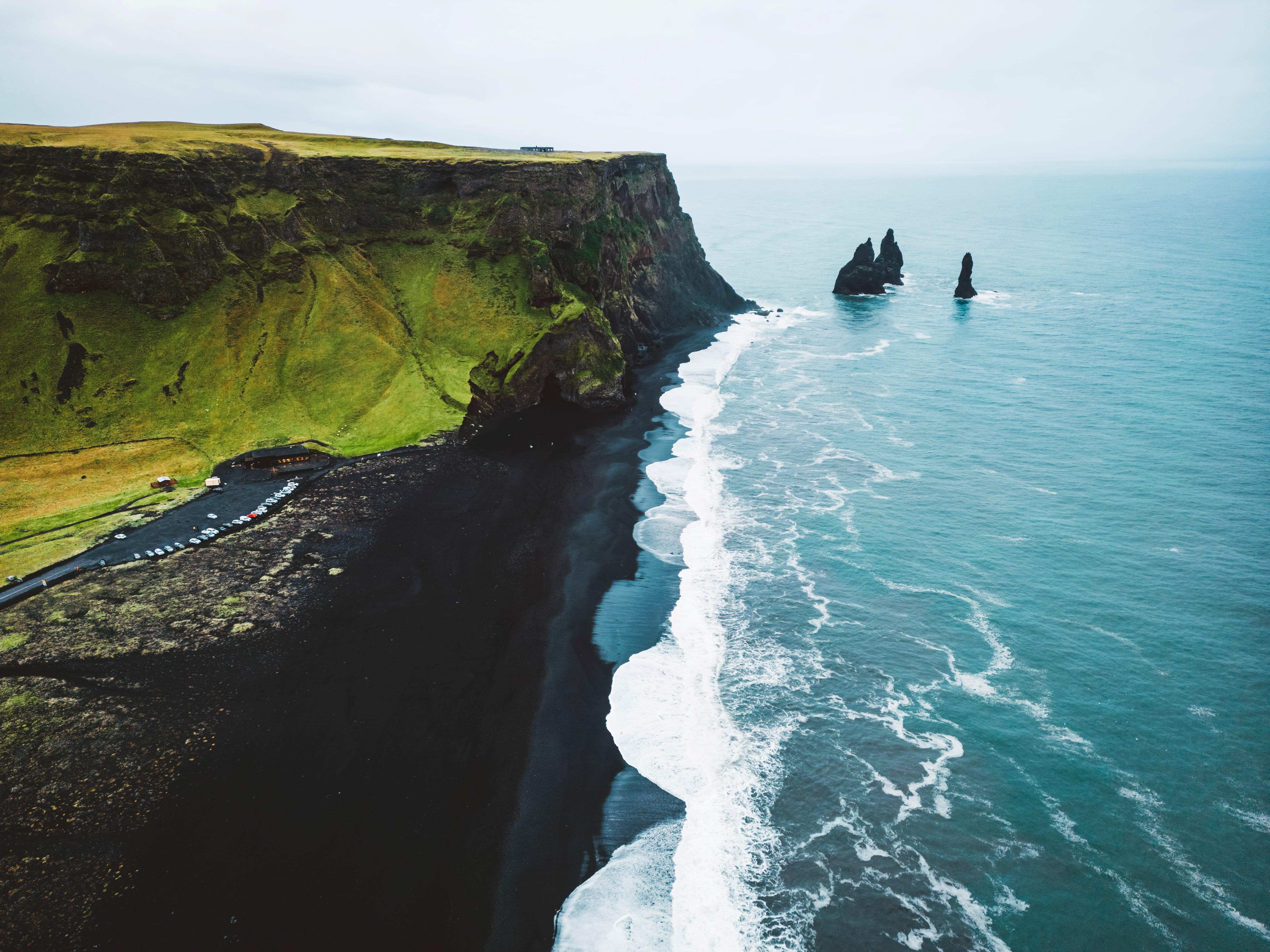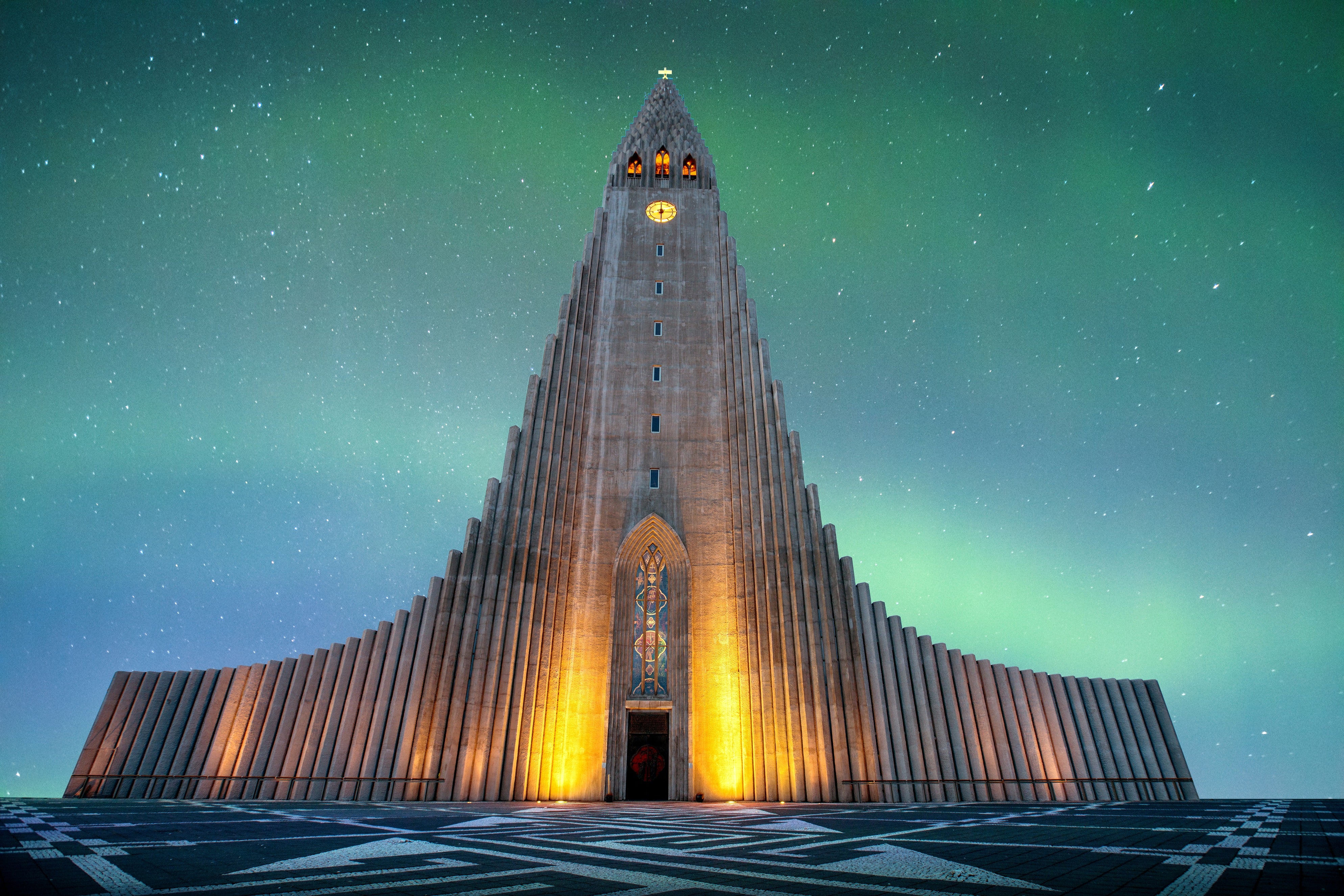
Surrounded by rhyolite hills, boiling vents, and patches of snow that often last well into summer, Hrafntinnusker Mountain Peak is one of the most surreal stops on the famous Laugavegur Hiking Trail, drawing adventurous hikers into the heart of Iceland's raw volcanic wilderness.
Reaching Hrafntinnusker Mountain Peak is part of what makes it so special. The isolation, shaped by its high elevation, shifting weather, and lack of road access, gives the area a raw, untouched character.
Why You Can Trust Our Content
Guide to Iceland is the most trusted travel platform in Iceland, helping millions of visitors each year. All our content is written and reviewed by local experts who are deeply familiar with Iceland. You can count on us for accurate, up-to-date, and trustworthy travel advice.
Key Takeaways
- A Remote Highland Escape: Hrafntinnusker Mountain Peak offers a rare sense of isolation, perched high in the Icelandic Highlands and far from any road or settlement, perfect for those seeking raw, crowd-free wilderness.
- Only Reachable on Foot: There are no roads to Hrafntinnusker Mountain Peak. It’s accessible only by hiking, most commonly as part of the Laugavegur Trail between Landmannalaugar and Alftavatn Lake (Álftavatn).
- Surreal Highland Scenery: Visitors can walk through steaming geothermal landscapes, spot rare obsidian rock, explore summer snow caves, and enjoy wide views over untouched terrain.
- Best Time to Visit: From late June to August, the area transforms into a highland wonderland, with colorful rhyolite slopes, melting snow patches, and active geothermal features exposed under the midnight sun.
Physical Features of Hrafntinnusker Mountain Peak
 Hrafntinnusker is a 3,743-foot (1,140-meter) mountain in Iceland’s remote Highlands and lies within the Fjallabak Nature Reserve, a protected area known for its geothermal and volcanic features.
Hrafntinnusker is a 3,743-foot (1,140-meter) mountain in Iceland’s remote Highlands and lies within the Fjallabak Nature Reserve, a protected area known for its geothermal and volcanic features.
Although classified as a mountain, its name ends with “sker” (skerry), reflecting a regional naming tradition in parts of Southeast Iceland, where terms for hills, peaks, and skerries are often used interchangeably regardless of size.
The peak is part of the Torfajokull Volcanic System (Torfajökull), one of Iceland’s most active geothermal zones. Its landscape is defined by layers of pale rhyolite, black obsidian, and vibrant mineral deposits, giving the area a highly varied surface texture and coloration.
Obsidian—formed when acidic lava cools rapidly—is found in scattered chunks across the mountain, and the name Hrafntinnusker directly refers to this volcanic glass.
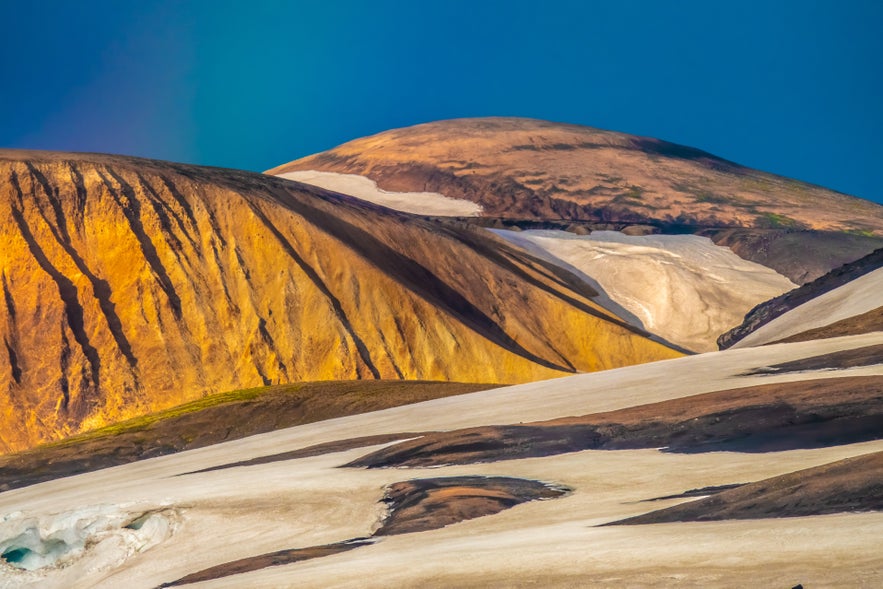 Despite its modest size, Hrafntinnusker Mountain Peak supports a tiny, persistent snowfield or glacier remnant at its summit, shaped both by seasonal snowfall and the geothermal heat that escapes from the ground below.
Despite its modest size, Hrafntinnusker Mountain Peak supports a tiny, persistent snowfield or glacier remnant at its summit, shaped both by seasonal snowfall and the geothermal heat that escapes from the ground below.
The combination of elevation, geothermal activity, and lingering snowfields makes the terrain harsh, rocky, and unusually colorful, with steam and ice often seen side by side.
The surrounding area, particularly to the west, contains a wide active geothermal zone filled with fumaroles, clay-rich hot springs, and steaming vents, some of which lie beneath glacial remnants. These underground forces continue to shape the mountain’s evolving form and contribute to the raw, dramatic character of this isolated landscape.
Where Is Hrafntinnusker Mountain Peak Located
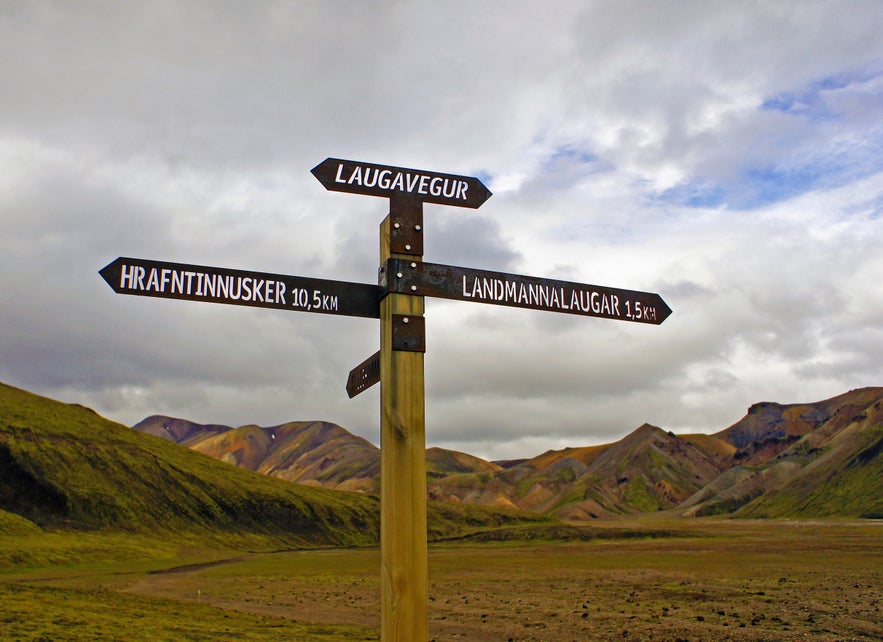 Hrafntinnusker Mountain Peak is located in the Icelandic Highlands, between Landmannalaugar and Alftavatn Lake, along the famous Laugavegur Trail. It sits at an elevation of 3,743 feet (1,140 meters) and lies within the Fjallabak Nature Reserve, an area known for its geothermal activity, colorful rhyolite mountains, and remote wilderness.
Hrafntinnusker Mountain Peak is located in the Icelandic Highlands, between Landmannalaugar and Alftavatn Lake, along the famous Laugavegur Trail. It sits at an elevation of 3,743 feet (1,140 meters) and lies within the Fjallabak Nature Reserve, an area known for its geothermal activity, colorful rhyolite mountains, and remote wilderness.
The peak is part of the Torfajokull Volcanic System, one of Iceland’s most active and geothermally rich regions.
While it may appear relatively central on the map, Hrafntinnusker Mountain Peak is extremely remote—there are no roads leading directly to it, and it is accessible only on foot, most commonly via the Laugavegur Trail.
The closest access point is Landmannalaugar, which serves as the trailhead for hikers heading south toward Thorsmork Glacial Valley (Þórsmörk).
Top Things To Do in Hrafntinnusker Mountain Peak
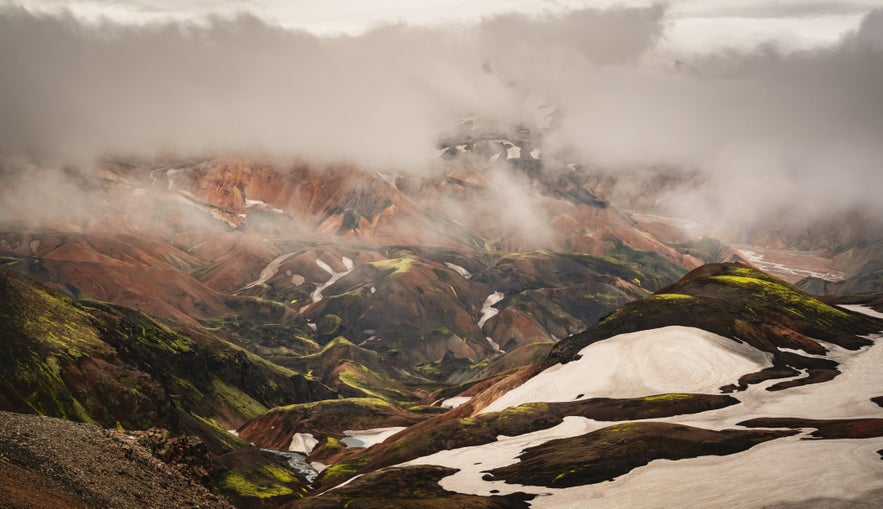 Hrafntinnusker Mountain Peak may be remote, but its raw landscape offers plenty to discover. Visitors can expect steaming vents, colorful rhyolite hills, obsidian fields, and lingering snow. It’s a natural playground for those hiking through Iceland’s wildest terrain.
Hrafntinnusker Mountain Peak may be remote, but its raw landscape offers plenty to discover. Visitors can expect steaming vents, colorful rhyolite hills, obsidian fields, and lingering snow. It’s a natural playground for those hiking through Iceland’s wildest terrain.
Here’s what you can do once you reach the peak of Hrafntinnusker Mountain:
Walk Through Steaming Geothermal Landscapes
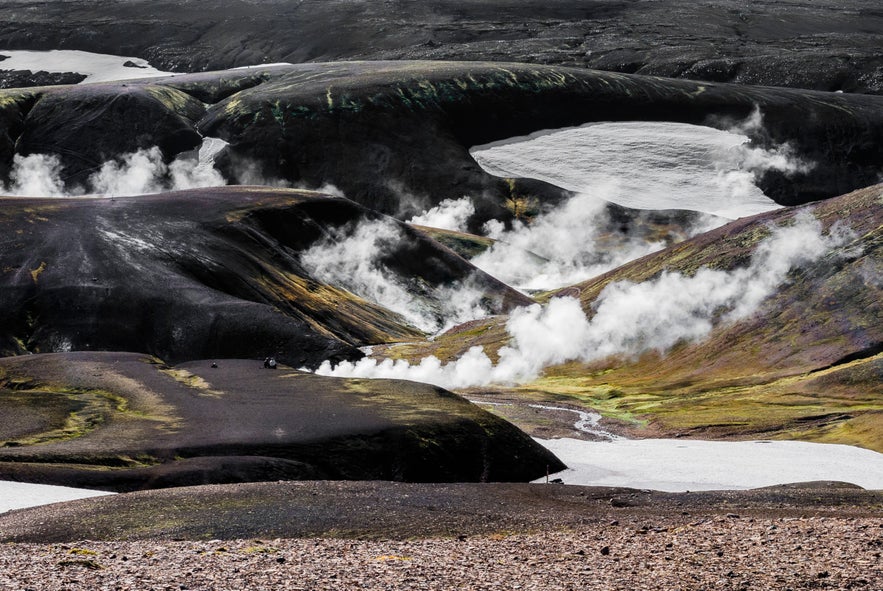 Explore the western side of Hrafntinnusker Mountain Peak, where steam constantly rises from the ground and the air smells faintly of sulfur. This active geothermal zone is filled with fumaroles, clay-rich hot springs, and steaming vents, some of which lie beneath patches of glacial ice.
Explore the western side of Hrafntinnusker Mountain Peak, where steam constantly rises from the ground and the air smells faintly of sulfur. This active geothermal zone is filled with fumaroles, clay-rich hot springs, and steaming vents, some of which lie beneath patches of glacial ice.
Follow safe paths through the area and watch the colors shift under your feet—from bright yellows and oranges to silvery whites—created by minerals like sulfur, iron, and silica.
Friendly reminder: Just be cautious around active vents, as the ground can be unstable near them.
To learn more about this natural phenomenon, take a look at some of Iceland’s other geothermal areas.
Find Obsidian Rocks in Iceland’s Wild Highlands
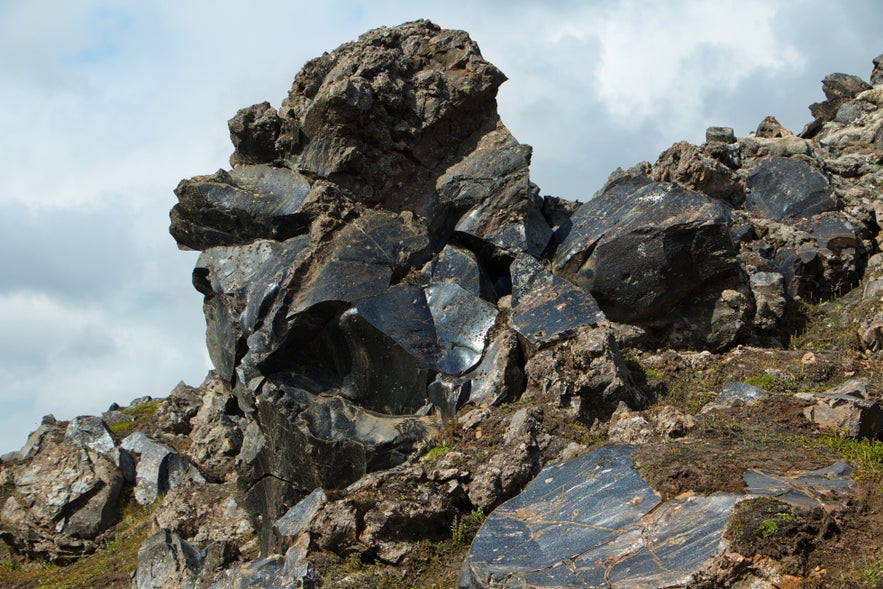 Keep an eye out for obsidian, a shiny black volcanic glass that gives Hrafntinnusker Mountain Peak its name (hrafntinna means obsidian in Icelandic).
Keep an eye out for obsidian, a shiny black volcanic glass that gives Hrafntinnusker Mountain Peak its name (hrafntinna means obsidian in Icelandic).
Formed from rapidly cooled lava, these glass-like fragments can be found throughout the area, but are easier to spot near the hut and along the eastern and southeastern slopes, where snow melts earlier and the terrain is more open. Obsidian is also present near geothermal zones, where heat and erosion expose ancient lava layers.
These dark shards scattered across the landscape add a striking visual contrast to the colorful rhyolite surroundings.
Spot Snow Caves Hidden in the Summer Snowfields
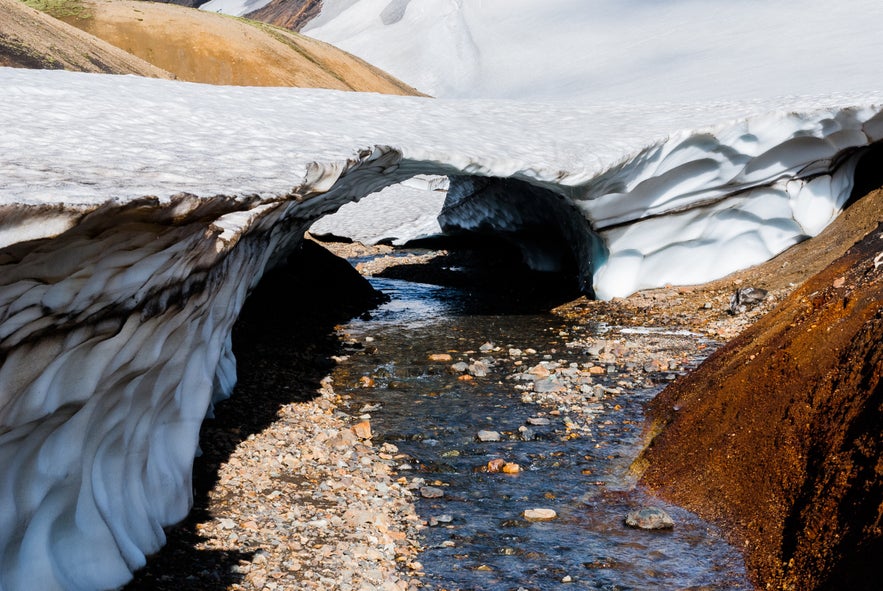 Even in midsummer, snow still lingers around Hrafntinnusker Mountain Peak’s high elevations. As you walk through the area, keep an eye out for shallow hollows or rising steam where the snow looks thin. In these spots, geothermal heat from below can melt the snow and create temporary snow caves, especially where ice and warm ground meet.
Even in midsummer, snow still lingers around Hrafntinnusker Mountain Peak’s high elevations. As you walk through the area, keep an eye out for shallow hollows or rising steam where the snow looks thin. In these spots, geothermal heat from below can melt the snow and create temporary snow caves, especially where ice and warm ground meet.
These hollow formations may appear near glacial remnants or geothermal features.
Friendly Reminder: As beautiful as they are, snow caves here are highly unstable. Melting from below can cause parts of the ceiling to collapse without warning. Always observe them from a safe distance.
Marvel at the Rhyolite Peaks and Lava Formations
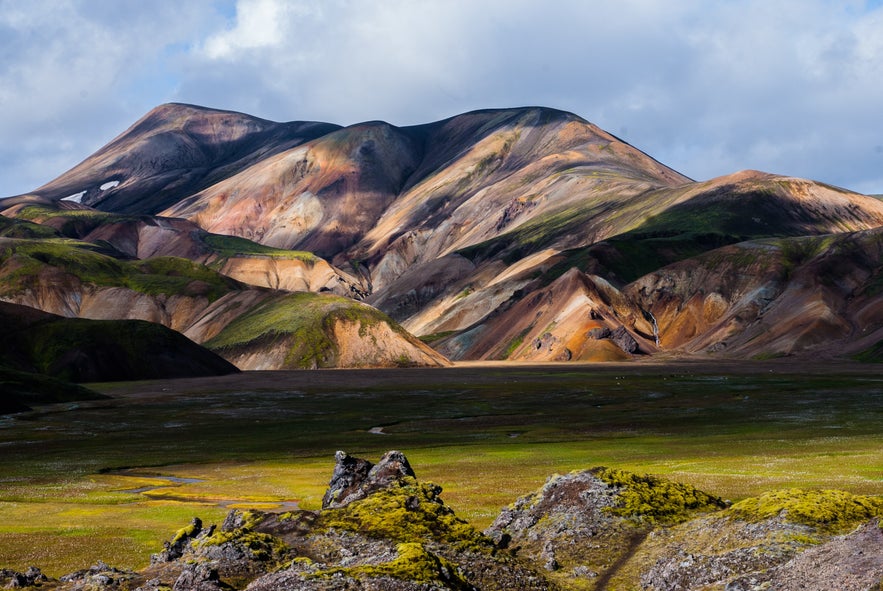 Take time to explore the rhyolite ridges and lava formations surrounding Hrafntinnusker. Follow the trail up to higher viewpoints or walk short detours around the hut to see the colorful slopes up close.
Take time to explore the rhyolite ridges and lava formations surrounding Hrafntinnusker. Follow the trail up to higher viewpoints or walk short detours around the hut to see the colorful slopes up close.
The rhyolite here is rich in minerals, giving the peaks their soft reds, greens, yellows, and pinks, especially striking when framed by snow patches or drifting steam.
Look for jagged lava fields and warped rock formations shaped by ancient eruptions within the Torfajokull Volcanic System. These striking remnants reveal the volcanic power that helped form the surrounding highlands.
Note: If you want more of this, check out some of the best volcano tours in Iceland.
Watch the Midnight Sun Over the Mountains
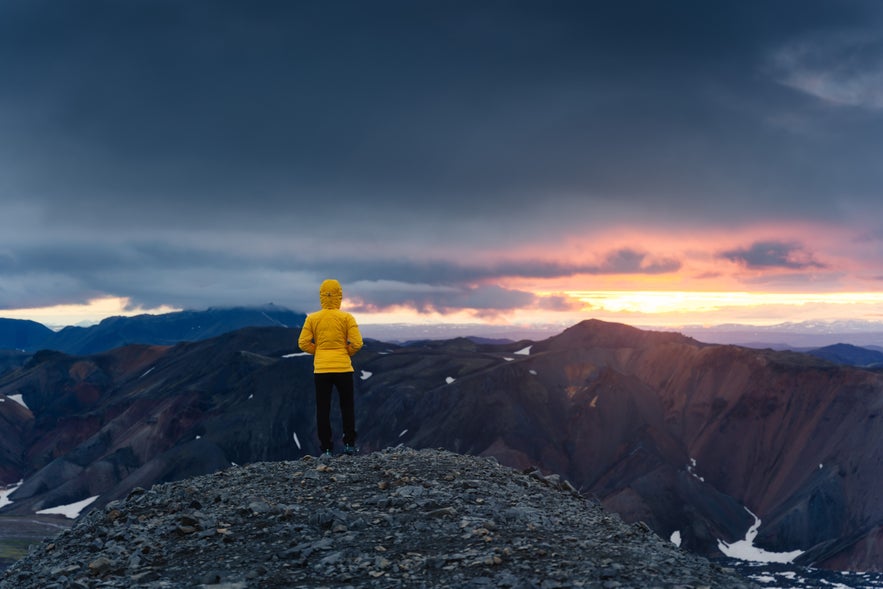 If you're visiting in late June or early July, take time in the evening to experience the midnight sun as it appears in Iceland’s Highlands. While the sun briefly dips below the horizon at this latitude, the sky remains brightly lit through the night, casting a golden glow across Hrafntinnusker’s snowfields, obsidian patches, and rhyolite peaks.
If you're visiting in late June or early July, take time in the evening to experience the midnight sun as it appears in Iceland’s Highlands. While the sun briefly dips below the horizon at this latitude, the sky remains brightly lit through the night, casting a golden glow across Hrafntinnusker’s snowfields, obsidian patches, and rhyolite peaks.
The high elevation and total absence of light pollution make the moment feel even more surreal.
Tip: Even when the sky stays bright, temperatures can drop fast at this altitude. Layer up and keep an eye on the weather if you're staying out late.
Staying Overnight at Hrafntinnusker Mountain Peak
 Perched at 1,100 meters above sea level on the eastern side of the mountain, the Hrafntinnusker Hut, officially known as Hoskuldsskali (Hoskuldsskáli), has served as a vital stop for Laugavegur Trail hikers since it was built in 1977.
Perched at 1,100 meters above sea level on the eastern side of the mountain, the Hrafntinnusker Hut, officially known as Hoskuldsskali (Hoskuldsskáli), has served as a vital stop for Laugavegur Trail hikers since it was built in 1977.
Operated by the Icelandic Touring Association (Ferðafélag Íslands, FÍ), the hut offers basic accommodation for up to 52 people and is typically the first overnight stop for those hiking south from Landmannalaugar.
The main hut has bunk beds, a communal kitchen, cold running water, and dry toilets, but there are no showers or electricity. A warden’s cabin sits just west of the main building, and an additional latrine is located down by the camping area, which rests on gravel, sand, or snow, depending on the conditions.
Icelandic camping is allowed near the hut, but keep in mind that the high altitude and exposure mean nights can be extremely cold, even in mid-summer.
 The site is only accessible on foot, and although a rough dirt road exists, it is almost never used except to deliver supplies. All guests are expected to pack out their trash and leave no trace.
The site is only accessible on foot, and although a rough dirt road exists, it is almost never used except to deliver supplies. All guests are expected to pack out their trash and leave no trace.
Day visitors must pay a small facility fee to use the outdoor toilets, benches, and grill area. This fee goes directly toward maintaining and improving facilities across Iceland’s fragile highland areas.
The hut is open and staffed only during summer, typically from late June to mid-September, depending on trail and road conditions in the Fjallabak Nature Reserve.
Note: Reservations are essential for overnight stays, as space fills quickly during the hiking season.
How To Get to Hrafntinnusker Mountain Peak
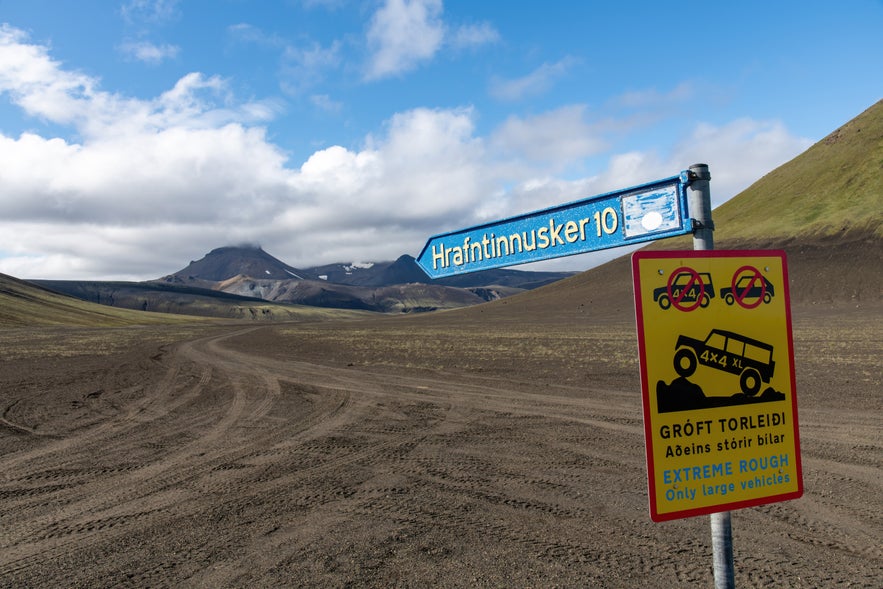 Reaching Hrafntinnusker Mountain Peak takes preparation, as it sits deep in the Highlands with no road leading directly to it. Most visitors arrive by hiking the Laugavegur Trail, while others join guided tours that include the area as part of a longer trek.
Reaching Hrafntinnusker Mountain Peak takes preparation, as it sits deep in the Highlands with no road leading directly to it. Most visitors arrive by hiking the Laugavegur Trail, while others join guided tours that include the area as part of a longer trek.
Below are the main ways to get there, depending on your travel plans.
By Hiking
The most common way to reach Hrafntinnusker Mountain Peak is by hiking from Landmannalaugar, the northern trailhead of the Laugavegur Trail. The route is around 7.5 miles (12 kilometers) and usually takes 4 to 5 hours to complete, depending on trail conditions and experience level.
The trail begins at the Landmannalaugar Campsite, which has facilities for campers and day hikers. From there, the well-marked path climbs steadily past steaming fumaroles, bubbling mudpots, and colorful rhyolite hills.
You’ll pass through rugged lava fields and small steep valleys, and eventually cross snowfields near a mountain pass before descending to the Hrafntinnusker Hut.
Tip: Check out this guide to hiking through Iceland’s Highlands for a better idea of what to expect on the trail.
By Car
While you can’t drive directly to Hrafntinnusker Mountain Peak, you can begin your journey by car to reach the nearest access point. Most travelers start from Reykjavik and drive to Landmannalaugar, the northern starting point of the Laugavegur Trail.
From Reykjavik, follow Route 1 (Ring Road) southeast toward Hella. At Hella, turn onto Route 26, then connect to the F-roads (such as F208) that lead into the Highlands and onto Landmannalaugar. These mountain roads are gravel, rough, and often involve river crossings, so a well-equipped 4x4 vehicle is required.
Once in Landmannalaugar, the rest of the journey continues on foot along the Laugavegur Trail.
Important: The Highland routes typically open between mid-June and early September, depending on weather and road conditions. Always check conditions with Vegagerdin (Vegagerðin), the Icelandic Road and Coastal Administration, before driving into the Highlands.
You can also look into self-drive tours in Iceland, which come with pre-planned routes and accommodation. Or, if you prefer to plan your own itinerary, simply rent a 4WD vehicle in Iceland suitable for the Highland roads.
By Guided Multi-Day Tours
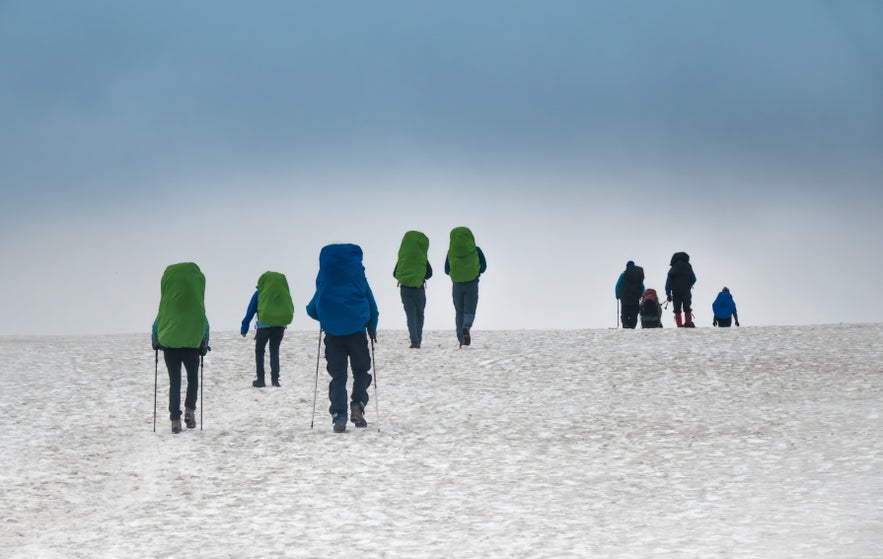 Hrafntinnusker Mountain Peak is a featured stop on several multi-day guided hiking tours along the renowned Laugavegur Trail. These treks typically start in Landmannalaugar and end in Thorsmork Glacial Valley, with Hrafntinnusker serving as the first overnight location.
Hrafntinnusker Mountain Peak is a featured stop on several multi-day guided hiking tours along the renowned Laugavegur Trail. These treks typically start in Landmannalaugar and end in Thorsmork Glacial Valley, with Hrafntinnusker serving as the first overnight location.
Participants are accompanied by experienced guides, and logistics such as accommodation in mountain huts, meals, and luggage transport are often included.
Here are some top guided multi-day tours that include Hrafntinnusker as part of the Laugavegur Trail experience:
- 3-Day Laugavegur Hiking Tour: A fast-paced guided hike from Landmannalaugar to Thorsmork Glacial Valley, passing through Hrafntinnusker, Alftavatn Lake, obsidian deserts, and black sand valleys. It’s ideal for fit hikers seeking a shorter, high-intensity version of the iconic trail.
- 4-Day Small-Group Laugavegur Trek: A small-group hike from Landmannalaugar to Thorsmork Glacial Valley with tent accommodations, luggage transfer, meals, and a guide included. The route covers Hrafntinnusker, Alftavatn Lake, and the glacial valleys of Thorsmork, offering an immersive, back-to-nature experience.
- 5-Day Laugavegur Trek with South Coast and Glacier Hike: Combines the full Laugavegur Trail with a glacier hike on Solheimajokull Glacier (Sólheimajökull). Includes four nights of accommodation (three in mountain huts, one in a hotel), meals, luggage transport, and a visit to South Coast highlights like Skogafoss (Skógafoss) and Seljalandsfoss waterfalls.
- 6-Day Laugavegur & Fimmvorduhals Trek: A full hut-to-hut hiking experience from Landmannalaugar to Thorsmork Glacial Valley, continuing over the Fimmvorduhals Pass (Fimmvörðuháls) between Eyjafjallajokull (Eyjafjallajökull) and Myrdalsjokull (Mýrdalsjökull) glaciers. Ideal for seasoned hikers seeking a deeper Highlands adventure.
- 7-Day Laugavegur Trek with South Coast Highlights: A comprehensive adventure combining the full Laugavegur Trail with Fimmvorduhals Pass, glacier hiking on Solheimajokull, and visits to South Coast gems like Skogafoss and Seljalandsfoss. Includes six nights of accommodation (five in huts, one hotel), meals, and luggage transport, ideal for those wanting both remote trekking and classic sightseeing.
Tip: You can also explore the best Highland tours in Iceland if you're looking for even more adventure.
Best Time To Visit Hrafntinnusker Mountain Peak
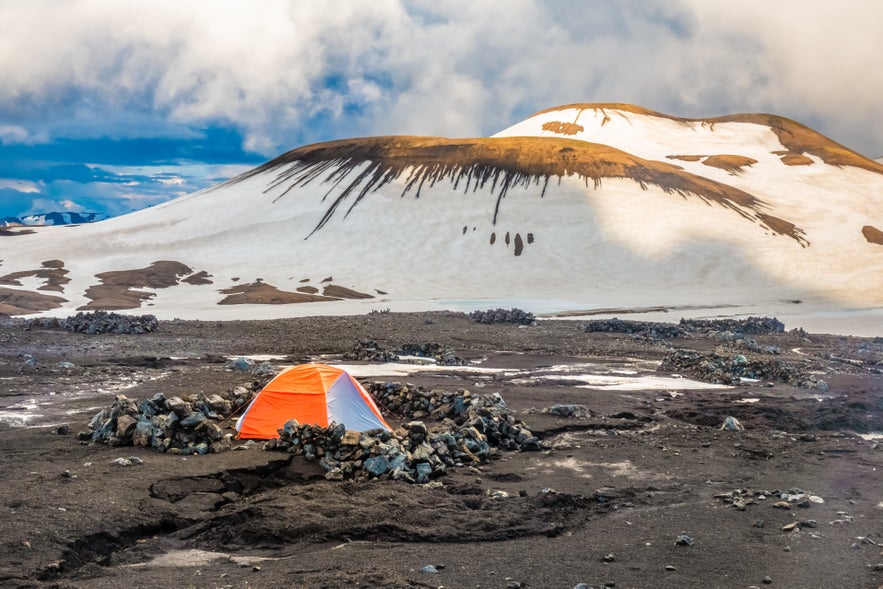 The best time to visit Hrafntinnusker Mountain Peak is during the short summer season, typically from late June to mid-September. This is when the Laugavegur Trail is open, Highland roads are accessible, and the mountain hut at Hrafntinnusker Mountain Peak is staffed.
The best time to visit Hrafntinnusker Mountain Peak is during the short summer season, typically from late June to mid-September. This is when the Laugavegur Trail is open, Highland roads are accessible, and the mountain hut at Hrafntinnusker Mountain Peak is staffed.
During this window, snow has usually melted enough to reveal the region’s rhyolite slopes, lava fields, and geothermal features, while lingering snow patches and high-altitude steam vents still create a surreal contrast.
Outside of summer, Hrafntinnusker Mountain Peak is inaccessible for most travelers due to heavy snow, unpredictable weather, and closed Highland roads.
Safety Tips for Visiting Hrafntinnusker Mountain Peak
 Due to its remote location and high elevation, Hrafntinnusker Mountain Peak requires solid preparation and awareness, even in summer. Here are essential safety tips, grouped by stage of your visit:
Due to its remote location and high elevation, Hrafntinnusker Mountain Peak requires solid preparation and awareness, even in summer. Here are essential safety tips, grouped by stage of your visit:
Before You Go
- Travel during summer only: Visit from late June to mid-September, when the trail and roads are open. Outside this window, travel is not advised unless you’re an expert hiker with advanced gear and winter experience.
- Plan accommodations and transport in advance: The mountain hut fills quickly, and buses or 4x4 routes into the Highlands may be limited.
- Check conditions before setting out: Always review trail and weather updates through sources like Vegagerdin or local hut wardens.
- Share your travel plans: Let your loved ones know your route and expected arrival time. Also, register your journey through safetravel.is.
- Pack food and water: There are no shops or refill points along the trail.
- Bring navigation tools: Carry offline trail maps or a GPS device, as snow or fog can hide trail markers.
- Charge your phone: Bring a fully charged device and a power bank, though mobile reception may be unreliable.
While Exploring
- Stay on marked trails: Venturing off-path risks damaging delicate terrain and getting lost.
- Dress in layers and waterproofs: Be ready for rain, wind, and sudden temperature changes, even in midsummer. You can also rent camping equipment in Iceland.
- Use sun protection: UV rays are stronger at high altitudes, especially when reflected off snow.
- Know when to turn back: If the weather worsens or visibility drops, don’t risk continuing.
On-Site Safety
- Don’t enter ice caves: They are extremely unstable and can collapse without warning due to geothermal melting from below.
- Watch your step around geothermal features: Ground near fumaroles or hot springs may be thin or unstable.
- Use caution near snowfields and steep terrain: Ice bridges and valleys can be hazardous, especially early or late in the season.
Important: In case of emergency, call 112 (Iceland’s national emergency line).
During summer, the warden at the Hrafntinnusker Hut can provide assistance on site and communicate with emergency services if needed. For added safety, download the 112 Iceland app to share your GPS location with emergency services, even if you have limited signal.
Attractions Near Hrafntinnusker Mountain Peak
 Hrafntinnusker Mountain Peak sits along one of Iceland’s top adventure spots and most scenic trekking routes, surrounded by colorful mountains, lava fields, and geothermal wonders.
Hrafntinnusker Mountain Peak sits along one of Iceland’s top adventure spots and most scenic trekking routes, surrounded by colorful mountains, lava fields, and geothermal wonders.
Here are the top nearby attractions, listed roughly in order of proximity:
- Torfajokull Volcano (Torfajökull) – A nearby glacier-volcano system just west of Hrafntinnusker, surrounded by steaming vents and colorful rhyolite formations.
- Alftavatn Lake – Located just south of Hrafntinnusker, this calm mountain lake and hut area is a common second overnight stop for Laugavegur hikers.
- Frostastadavatn Lake (Frostastaðavatn) – A crater lake surrounded by mossy lava flows, located just before reaching Landmannalaugar.
- Blahnjukur Volcano (Bláhnjúkur) – A striking blue-gray mountain offering panoramic views, with a popular summit trail near Landmannalaugar.
- Mt. Brennisteinsalda – A multicolored rhyolite mountain with visible steam vents, easily accessible from the Landmannalaugar area.
- Landmannalaugar – The northern starting point of the Laugavegur Trail, known for its hot springs, colorful slopes, and well-equipped campsite.
- Thorsmork Glacial Valley– A lush glacial valley marking the southern end of the trail, filled with green canyons, braided rivers, and hiking routes.
- Fjallabak Nature Reserve – The wider protected area that encompasses Hrafntinnusker and many of the surrounding landscapes.
Hike the Iconic Hrafntinnusker Mountain Peak in Iceland
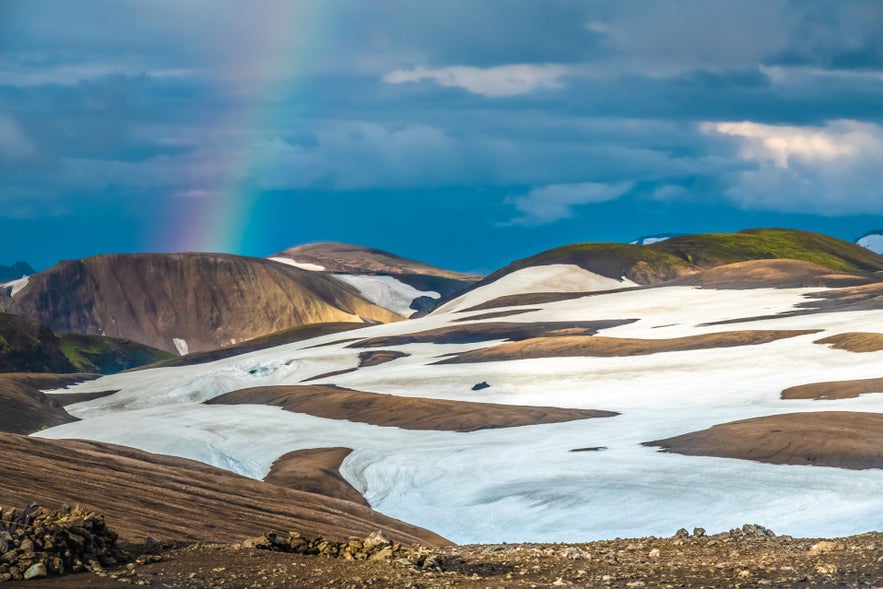 Hrafntinnusker Mountain Peak isn’t just a stop on the Laugavegur Trail—it’s a highlight of Iceland’s remote interior, where steaming vents, obsidian fields, and colorful rhyolite meet highland snow. Its isolation, dramatic scenery, and raw volcanic terrain offer a hiking experience unlike anywhere else in the country.
Hrafntinnusker Mountain Peak isn’t just a stop on the Laugavegur Trail—it’s a highlight of Iceland’s remote interior, where steaming vents, obsidian fields, and colorful rhyolite meet highland snow. Its isolation, dramatic scenery, and raw volcanic terrain offer a hiking experience unlike anywhere else in the country.
While reaching it takes effort, the reward is unforgettable. Whether you’re tackling the full Laugavegur trail or hiking in from Landmannalaugar, Hrafntinnusker Mountain Peak gives you a rare chance to step into Iceland’s untamed heart and see what it truly means to walk where fire and ice still shape the land.
If you’re looking to explore more of Iceland on foot, check out our complete guide to the best hikes and trails in Iceland. You can also browse the top-rated guided hiking and trekking tours for a more structured adventure.
